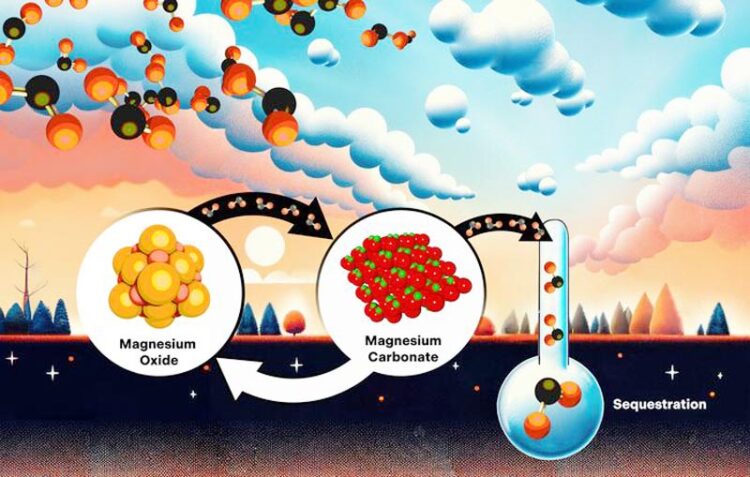Time-tested magnesium oxide

In a proposed carbon-capture method, magnesium oxide crystals on the ground bind to carbon dioxide molecules from the surrounding air, triggering the formation of magnesium carbonate. The magnesium carbonate is then heated to convert it back to magnesium oxide and release the carbon dioxide for placement underground, or sequestration.
Credit: Adam Malin/ORNL, U.S. Dept. of Energy
Unveiling CO2 absorption dynamics.
Magnesium oxide is a promising material for capturing carbon dioxide directly from the atmosphere and injecting it deep underground to limit the effects of climate change. But making the method economical will require discovering the speed at which carbon dioxide is absorbed and how environmental conditions affect the chemical reactions involved.
Scientists at the Department of Energy’s Oak Ridge National Laboratory analyzed a set of magnesium oxide crystal samples exposed to the atmosphere for decades, and another for days to months, to gauge the reaction rates. They found that carbon dioxide is taken up more slowly over longer time periods because of a reacted layer that forms on the surface of the magnesium oxide crystals.
“This reacted layer is a complicated mix of different solids, which limits the ability of carbon dioxide molecules to find fresh magnesium oxide to react with. To make this technology economical, we are now looking at ways to overcome this armoring effect,” said ORNL’s Juliane Weber, the project’s principal investigator. Andrew Stack, a scientist at ORNL and team member on the project, followed: “If we can do so, this process might be able to achieve the Carbon Negative Energy Earthshot goal of capturing gigaton levels of carbon dioxide from air for less than $100 per metric ton of carbon dioxide.”
Most of the previous research, aimed at understanding how fast the magnesium oxide and carbon dioxide chemical reactions occur, relied on rough calculations rather than materials testing. The ORNL study marks the first time a multidecade test has been conducted to determine the reaction rate over long time scales. Using transmission electron microscopy at the Center for Nanophase Materials Science, or CNMS, at ORNL, the researchers found that a reacted layer forms. This layer consists of a variety of complex crystalline and amorphous hydrated and carbonate phases.
“Additionally, by performing some reactive transport modeling computer simulations, we determined that as the reacted layer builds up, it gets better and better at blocking carbon dioxide from finding fresh magnesium oxide to react with,” ORNL’s researcher Vitaliy Starchenko said. “Thus, going forward, we are looking at ways to bypass this process to allow carbon dioxide to find fresh surface with which to react.”
The computer simulations help scientists and engineers understand how the reacted layer evolves and changes the way in which substances move through it over time. Computer models enable predictions concerning the reactions and movement of materials in natural and engineered systems, such as materials sciences and geochemistry.
The DOE Office of Science primarily supported the work. ORNL’s Laboratory Directed Research and Development program supported time-of-flight, or TOF, secondary ion mass spectrometry, or SIMS, and preliminary transmission electron microscopy, or TEM. Atomic force microscopy-TOF-SIMS and TEM characterizations were conducted as part of a user project at the CNMS, a DOE Office of Science user facility at ORNL.
UT-Battelle manages ORNL for DOE’s Office of Science, the single largest supporter of basic research in the physical sciences in the United States. The Office of Science is working to address some of the most pressing challenges of our time. For more information, please visit energy.gov/science.
Journal: Environmental Science & Technology
DOI: 10.1021/acs.est.3c04690
Method of Research: Experimental study
Subject of Research: Not applicable
Article Title: Armoring of MgO by a Passivation Layer Impedes Direct Air Capture of CO2
Article Publication Date: 22-Sep-2023
Media Contact
Scott Gibson
DOE/Oak Ridge National Laboratory
gibsonws@ornl.gov
Cell: 8652066499
All latest news from the category: Ecology, The Environment and Conservation
This complex theme deals primarily with interactions between organisms and the environmental factors that impact them, but to a greater extent between individual inanimate environmental factors.
innovations-report offers informative reports and articles on topics such as climate protection, landscape conservation, ecological systems, wildlife and nature parks and ecosystem efficiency and balance.
Newest articles

First-of-its-kind study uses remote sensing to monitor plastic debris in rivers and lakes
Remote sensing creates a cost-effective solution to monitoring plastic pollution. A first-of-its-kind study from researchers at the University of Minnesota Twin Cities shows how remote sensing can help monitor and…

Laser-based artificial neuron mimics nerve cell functions at lightning speed
With a processing speed a billion times faster than nature, chip-based laser neuron could help advance AI tasks such as pattern recognition and sequence prediction. Researchers have developed a laser-based…

Optimising the processing of plastic waste
Just one look in the yellow bin reveals a colourful jumble of different types of plastic. However, the purer and more uniform plastic waste is, the easier it is to…



